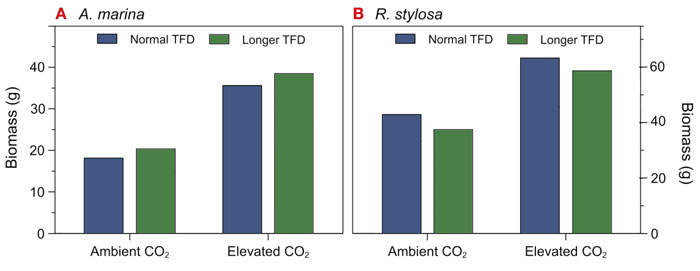| Tweet | Follow @co2science |
Paper Reviewed
Jacotot, A., Marchand, C. and Allenbach, M. 2019. Increase in growth and alteration of C:N ratios of Avicennia marina and Rhizophora stylosa subject to elevated CO2 concentrations and longer tidal flooding duration. Frontiers in Ecology and Evolution 7: 98, doi: 10.3389/fevo.2019.00098.
Forested mangrove ecosystems typically develop along tropical and subtropical coastlines and are mainly composed of salt-tolerant trees. However, much remains to be learned in regard to how these highly productive ecosystems might respond to future climate change.
As their contribution to the topic, Jacotot et al. (2019) grew seedlings of two tree species, grey mangrove (Avicennia marina) and stilted mangrove (Rhizophora stylosa), under two CO2 concentrations (400 or 800 ppm) over a period of one year. In addition, half of the trees in each CO2 treatment were subjected to a normal tidal flooding cycle and half to a tidal cycle that was 1.75 hours longer than normal. The extended tidal cycle allowed for a longer duration of tidal flooding, which circumstance is hypothesized to occur in the future in response to projections of sea level rise.
So what did their study reveal?
At the end of the experiment, Jacotot et al. report that the doubling of atmospheric CO2 from 400 to 800 ppm resulted in an increase of total plant biomass of 95.5% and 88.5% for A. marina and 47.5% and 56.3% for R. stylosa under normal and extended tidal flooding cycles, respectively (see figure below). The increase in total plant biomass was the product of photosynthesis enhancement by elevated CO2, which increased the biomass both above and below ground. Commenting on the increased below ground biomass, the authors write that it should "lead to soil vertical accretion, thus helping mangroves to face sea-level rise." What is more, they note that it will also likely "favor seedling establishment and mangrove colonization of new available spaces resulting from sea-level rise." And the good news does not end here.
According to the researchers, "future increases in surface temperature will further stimulate trees development, as seasons affected seedlings productivity with higher relative growth rates during the warmer period." What is more, they note that carbon:nitrogen ratios of seedling tissues "were increased under elevated CO2, which may lower organic matter degradation in mangrove soils [thereby] increasing carbon sequestration." Consequently, in light of these several positive findings, Jacotot et al. conclude that "future climate changes may enhance the productivity of mangrove seedlings by increasing their growth, which may in turn increase the carbon storage potential of mangroves."

Figure 1. Total plant biomass of A. marina and R. stylosa tree seedlings after 1-year exposure to ambient (400 ppm) or elevated (800 ppm) CO2 concentrations under a normal tidal cycle or an extended tidal cycle that was 1.75 hours longer than normal. Source: adapted from Jacotot et al. (2019).




